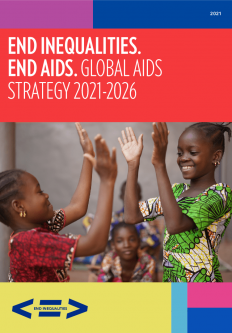The Joint United Nations Programme on AIDS (UNAIDS) has released a new global AIDS strategy for the next five years. The plan sets targets and lays out policies that will not only help end AIDS as a global health threat by 2030 but also get those efforts back on track after the setbacks posed by the COVID-19 pandemic. What’s more, the plan focuses on health equity by taking aim at the inequalities that fuel the HIV/AIDS epidemic.
For the strategy to succeed, it will cost an estimated $29 billion a year, according to a press release on the report by UNAIDS.
The new #GlobalAIDSStrategy puts people at the centre of the response and aims to unite countries, communities and partners to take prioritized actions to ensure that all people affected by HIV have access to life-saving HIV services.#EndInequalitiesEndAIDS
— UNAIDS (@UNAIDS) March 27, 2021
Titled End Inequalities. End AIDS. UNAIDS Global AIDS Strategy 2021-2026, the strategy also highlights the need to help population groups that face discrimination, stigma and unequal access to HIV education, prevention and care. These groups include girls and young women in sub-Saharan Africa, people in prison, sex workers, transgender people, men who have sex with men and people who inject drugs.
“Most countries and communities are not on track to end AIDS by 2030,” states the strategy’s executive summary, adding, “Ending AIDS is possible, but a course correction is needed.
“Much progress has been made among some groups of people and in some parts of the world,” according to the summary. “A few countries have reached AIDS epidemic control, and others are close to doing so. By 2019, more than 40 countries had surpassed or were within reach of the key epidemiological milestone towards ending AIDS. Millions of people living with HIV now enjoy long and healthy lives, and the number of new HIV infections and AIDS-related deaths are on the decline. Of the 38 million people living with HIV, 26 million were accessing lifesaving antiretroviral therapy (ART) as of June 2020. This treatment results in viral load suppression, which prevents the spread of HIV.”

The cover of the new global AIDS strategyCourtesy of UNAIDS.org
The report refers to a fact known as Untransmittable Equals Untransmittable, or U=U, which means that people living with HIV who maintain an undetectable viral load by taking meds not only enjoy healthier and longer lives but also cannot transmit the virus through sex.
The main priorities of the new UNAIDS five-year strategy are:
- Maximize equitable and equal access to comprehensive people-centered HIV services.
- Break down legal and societal barriers to achieving HIV outcomes.
- Fully resource and sustain HIV responses and integrate them into systems for health, social protection and humanitarian settings.
Achieving the strategy’s five-year targets means that:
- The number of people who newly acquire HIV will decrease from 1.7 million in 2019 to less than 370,000 by 2025.
- The number of people dying from AIDS-related illnesses will decrease from 690,000 in 2019 to less than 250,000 by 2025.
- The number of new HIV infections among children will drop from 150,000 in 2019 to fewer than 22,000 in 2025.
“This year marks 40 years since the first cases of AIDS were reported and 25 years since the establishment of UNAIDS,” said Winnie Byanyima, executive director of UNAIDS in the press release. “We are at a critical moment in our historic effort to end AIDS.” “Like HIV before it, COVID-19 has shown that inequality kills. COVID-19 has widened existing inequalities that block progress to ending AIDS. That’s why I’m proud that our new strategy places tackling inequalities at its heart. We must seize this moment to ensure health equality for all in order to beat COVID-19 and end AIDS.”
The World Health Organization and the Global Network of People Living with HIV have endorsed the UNAIDS strategy.
Achieving the goals and targets of the new #GlobalAIDSStrategy will require annual HIV investments in low- and middle-income countries to rise to a peak of US$29 billion by 2025.
— UNAIDS (@UNAIDS) March 26, 2021
This is an investment the ???? cannot afford to miss!https://t.co/KZu3urKqXr #EndInequalitiesEndAIDS pic.twitter.com/EMG5z8iffA
In related news, see “United Nations General Assembly to Hold a High-Level Meeting on HIV/AIDS.” Additionally, during the past year, UNAIDS released a number of reports looking at COVID-19 through the lens of HIV. For POZ articles on those reports see:
- “HIV History Teaches Us How (and Why) to Reduce COVID-19 Stigma”
- “When COVID-19 Offers an Excuse to Violate Human Rights”
- “COVID-19 Criminalization: Seven Lessons From the HIV Response.”
In other global HIV news, Andrew Spieldenner, PhD, is the new executive director of MPact Global Action for Gay Men’s Health and Rights.







Comments
Comments